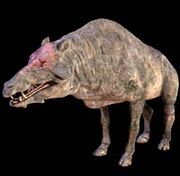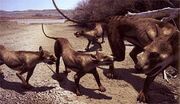| Oligocene | |||||||||
|---|---|---|---|---|---|---|---|---|---|

| |||||||||
| Previous period Eocene |
Following period Miocene | ||||||||
During this time, the world had just been through years of catastrophic climate change that led to the extinction of one species in five. Earth has since bounded back, but in the process, it’s become a changed world – different weather, different plants, and different animals. In places like Mongolia, some animals have grown enormous. In the Oligocene, large parts of the world have become highly seasonal. In Mongolia, long dry seasons are broken by short, violent, wet seasons. The climate has shaped not only the environment, but also the animals.
The Oligocene epoch (the named derived from the Greek words oligos - insignificant and cainos - new), was the third epoch of the Paleogene. It began roughly 37 MYA +/- 2, and ended approximately 25 MYA +/- 2, lasting for about 12 million years.
During the Oligocene, the sea levels dropped and Eurasia was formed, as Europe and Asia became a single landmass (though India joined them later).
The Oligocene epoch was marked by large changes among the fauna.

The first artiodactyl mammals did appear, as did the first true carnivores and the first apes.

The more ancient groups of animals (panthodonts, pyrotheres, creodonts) died.
The flora too changed during the Oligocene, as the tropical belts began to retreat and plants,

Hyaenodon (official image).
adapted to a more temparate climate, began to take over.
